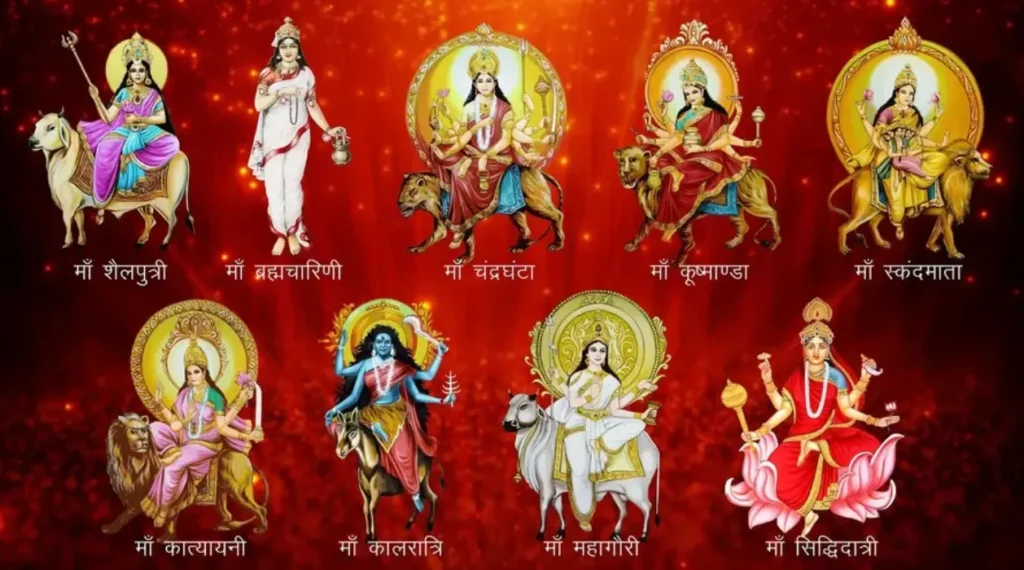
This Navratri, I dedicate the story of Nav Durga to society. For nine days, we engage in worship, celebrating the divine feminine in the form of Maa Durga. However, once the festival concludes, we often overlook the devine femininity and its notion that represents various forms. This oversight is not just societal but also a self-imposed limitation that women sometimes accept. Femininity is a profound strength that transcends the mere pursuit of equality with its male counterparts. Instead of just striving for parity, we should recognize and celebrate the unique power and influence that femininity holds. The journey of the Nav Durga provides invaluable lessons in this regard.
The Navdurga comprises nine distinct forms of Goddess Durga, each symbolizing a different phase in the life of a woman. These forms offer profound insights, illuminating not only their spiritual significance but also the stages of growth, learning, and transformation that resonate with the feminine experience.
1. Shailputri: The Daughter
Shailputri is the first manifestation of Durga, embodying the role of a daughter. Her name translates to “daughter of the mountains,” with “Shaila” meaning mountain and “Putri” meaning daughter. Riding a bull and wielding a trident and lotus, she represents the dual qualities of strength and purity. Shailputri’s innocence reflects the untapped potential within every young girl. As the daughter, she is rooted in the natural world, her association with mountains symbolizing stability and a solid foundation as she embarks on her journey of life.
2. Brahmacharini: The Student
In her second form, Brahmacharini represents the phase of learning, growth, and discipline. Eschewing weapons and the company of wild animals, her peaceful demeanor illustrates her unwavering commitment to acquiring knowledge and cultivating inner strength. This form signifies a young woman’s dedication to education and self-improvement, laying a robust foundation for future challenges. Through Brahmacharini, we learn the importance of personal growth and resilience in navigating life’s complexities.
3. Chandraghanta: The Warrior
The third form, Chandraghanta, embodies a woman’s assertion of strength and power. After marriage, she adopts the crescent moon on her forehead, symbolizing her union and balance between her individuality and partnership. Riding a fierce tiger and wielding an array of weapons, Chandraghanta is prepared to confront the challenges that life presents. The bell on her forehead resonates with the power of her voice, symbolizing self-assertion and the courage to dispel negativity. In this phase, she represents a woman’s journey into the warrior spirit, navigating married life while asserting her individuality.
4. Kushmanda: The Creator
Upon embracing motherhood, Chandraghanta transforms into Kushmanda. The name “Kushmanda,” derived from “Kush” meaning egg, signifies the cosmic egg, the source of all creation. This form highlights a woman’s transition into motherhood, showcasing her ability to create and nurture new life. Riding a lion and equipped with various weapons, Kushmanda symbolizes the strength and warmth essential for motherhood, illuminating the potential within every woman to bring forth new beginnings with love and care.
5. Skandamata: The Mother
Skandamata represents the nurturing aspect of motherhood. Depicted with her son Skanda (Lord Kartikeya) on her lap, she rides a lion, embodying selflessness, protection, and unconditional love. Skandamata signifies a crucial phase where a mother not only nurtures her child but also guides them with wisdom, ensuring their safety and growth.
6. Katyayani: The Seeker of Justice
Katyayani, the sixth form, embodies valor and justice. Riding a lion and wielding a sword, she stands ready to vanquish evil and restore righteousness. This phase signifies a woman’s commitment to justice and her courage in confronting oppression and fighting for truth, reflecting the fierce determination required to ensure justice in society.
7. Kalaratri: The Fearless Protector
Kalaratri is a formidable form that symbolizes the destruction of ignorance and darkness. Riding a donkey and wielding a sword and trident, she signifies the power of protection and the strength to overcome fear. This form teaches us the importance of confronting our deepest fears, embodying the qualities of fearlessness and protection.
8. Mahagauri: The Purifier
Mahagauri symbolizes purity, serenity, and compassion. Riding a white bull and carrying a trident, she represents the journey towards self-purification and spiritual awakening. This phase encourages women to shed past burdens, embrace tranquility, and seek inner peace.
9. Siddhidatri: The Giver of Wisdom
Siddhidatri, the ultimate form of Durga, bestows wisdom and supernatural powers. Seated on a lotus, she holds a discus, conch, mace, and lotus, representing the culmination of a woman’s journey toward enlightenment and inner peace.
Through the narrative of Nav Durga, we witness the essence of a woman’s journey from Shailputri to Siddhidatri, encompassing transformation, empowerment, and self-realization. Each form tells a unique story of strength, wisdom, and the spiritual growth inherent in womanhood.
As we reflect on these powerful narratives, let us remember that femininity is not just about equality but about embracing the unique strengths that women possess. It is a journey of internal battles and external challenges, breaking societal norms, and uplifting not only ourselves but also those around us. When a woman embodies all these aspects of life gracefully, she becomes an inspiration for others. Hence, we must honor these lessons from Maa Durga’s forms, encouraging ourselves and each other to embrace our femininity fully. Let us not merely worship but actively integrate these lessons into our lives, recognizing the profound power that resides within us all.

Recent Comments